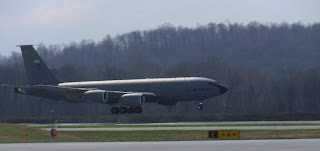Welcome to the twelfth regular installment of The Aircraft of MDT . In this series we are taking a look at some of the aircraft that you may spot flying to and from Harrisburg International Airport.
The KC-135 Stratotanker was the United States’ first jet powered tanker aircraft. Prior to its adoption in 1957, the U.S. Air Force’s primary tanker was the piston-engined KC-97 (also called the Stratotanker). The KC-97 served a vital role from the time it entered service in 1950, but it was not ideal for fueling jet aircraft. The fighters and bombers it typically served had to lower their speed and altitude in order to accommodate the relatively slow tanker. The jet-engined KC-135 solved this problem. Also, because the KC-135 operated on the same type of fuel that it was supplying to other aircraft, there was no need to keep the two supplies segregated. This change, along with its larger size, meant that the KC-135 could carry a fuel load more than three times the volume of the KC-97 (31,000+ gallons compared to 9,000 gallons).
 |
| Aft view of a KC-135. Note the boom control surfaces extending above the tailplane. |
The KC-135 Stratotanker was built by Boeing and is a sibling to their premier jetliner, the 707. The KC-135 is not a derivative of the 707; instead, both aircraft are derived from the 367-80 prototype that Boeing built in the early 50s. When the 135 was in development, it was known internally as “Model 717,” a designation that would later be used publically for the airliner that started life as the McDonnell Douglas MD-95.
The KC-135 Stratotanker employs a “flying boom” fueling system. This system uses a rigid boom that is lowered from the aft center of the tanker. The boom has flight control surfaces near its tip that allow it to be maneuvered by an operator aboard the tanker. Watching from a small window, the boom operator steadies the boom and extends it to mate with a receptacle on the receiver aircraft. Not all aircraft fit for aerial refueling are equipped for a flying boom system. The most common alternative system is the “probe and drogue,” in which a flexible hose with a cone-shaped drogue is lowered from the tanker, and the receiver aircraft positions itself to insert an extended probe. The boom on the KC-135 can be fitted with a drogue adapter that allows it to refuel aircraft of this type. In addition, some KC-135s have been outfitted with under-the-wing drogue refueling pods.
The KC-135 carries more than just fuel, too. It has an upper deck that can be outfitted to carry up to 83,000 pounds of passengers and cargo, depending on the fuel load. KC-135s have also been used by NASA. They have served as a platform in various research endeavors, and, until it was replaced in 2004, the KC-135 (minus the tanker equipment) functioned as NASA’s infamous “Vomit Comet.” Flown in parabolic arcs, the plane simulated weightlessness for astronaut trainees. One of the specially modified tankers was used to film scenes of weightlessness for the movie Apollo 13.
 |
| A KC-135 conducting touch-and-go maneuvers at MDT. |




No comments:
Post a Comment